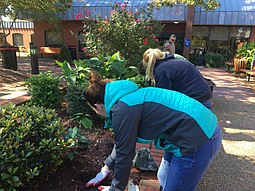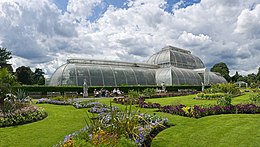Horticultural therapy
This article may need to be rewritten to comply with Wikipedia's quality standards. (May 2024) |
Horticultural therapy (also known as garden therapy or social and therapeutic horticulture) involves using gardening activities to promote human healing and rehabilitation.[1]

History[edit]
Alice Burlingame and Donald Watson authored the first book on horticultural therapy, Therapy through Horticulture, published in 1960.[2]
The first degree awarded for work in Horticultural Therapy was given in 1972.[3]
In 1973 the Council for Therapy and Rehabilitation through Horticulture (NCTRH) was established by a group of horticulture therapy professionals. In 1988, they changed their name to the American Horticulture Therapy Association (AHTA).[4]
Types of treatment[edit]
Goals and types of treatment vary depending on the facility using horticultural therapy. Institutions from schools and nursing homes to prisons utilize horticultural therapy to meet therapeutic needs. Each one of these facilities have different types of horticultural therapy, each with their own individual forms of treatment.[5] Fundamentally horticultural therapy can be divided into three types of programming: Vocational, therapeutic, and social.[6]
Vocational Horticultural Therapy[edit]
Vocational Horticultural Therapy is intended to teach skill and enhance behaviors that can be used in a job or workplace.[6] People undergoing vocational therapy can learn skills involving greenhouses, vegetable gardening, tree and shrub care, as well as learn about plant production, sales and services.[6] Activities vocational therapy teaches consists of how to repot, water, and move plants within their space. Learning the basic knowledge of their plants root system and the care different plants need is taught at their own pace.[6] Ultimately aimed at employment, vocational horticulture therapy teaches people how to grow and work with plants while also learning the benefits of supporting themselves mentally and financially.

Therapeutic Horticultural Therapy[edit]
Therapeutic Horticultural Therapy has its focus on medical and illness recovery.[6] The central belief that therapeutic horticulture therapy revolves around is that being in nature has restorative properties.[citation needed] Therapeutic horticulture might be used to try and improve physical activity, social skills and engagement.[6] Activities encompassed by therapeutic horticulture vary widely, some activities include: digging and watering, making observations about plant growth and change, relating plant life cycle to human life, and starting seeds.
A systematic review and meta-analysis of research comparing horticultural therapy with usual care and other non-pharmacological interventions for individuals with dementia found that participating in certain types of horticultural therapy activities appeared to improve cognitive functioning, agitation, positive emotion and engagement scores when compared to usual care and other non-pharmacological interventions.[7]
Social Horticultural Therapy[edit]
Social Horticultural Therapy is focused on leisure activity and enhancement of life quality.[6] Unlike therapeutic horticultural therapy, social horticultural therapy is more likely to be activity based.[6]
See also[edit]
References[edit]
- ^ Thompson, Paul B.; Kaplan, David M. (2012). Encyclopedia of Food and Agricultural Ethics. New York: Springer Verlag. p. 1537.
Horticultural therapy is the practice of using horticultural activities for human healing and rehabilitation.
- ^ Thompson, Paul B.; Kaplan, David M. (2012). Encyclopedia of Food and Agricultural Ethics. New York: Springer Verlag. p. 1538.
The first book in horticultural therapy, Therapy through Horticulture by Burlingame and Watson, was published in 1960 (Burlingame and Watson 1960).
- ^ Relf, Paula Diane. "Agriculture and health care". wur.nl. p. 317. Retrieved 22 May 2024.
In 1972, a program between the activity therapy department of the Menninger Foundation and the Horticulture Department of Kansas State University was established to train students undergraduate for the mental health field. This was the first horticultural-therapy curriculum in the United States. Dr. R. W. Campbell at Kansas State University directed this program. The University of Maryland awarded a Master of Science in Horticulture for work by P.D. Relf in Horticultural Therapy in 1972. In 1973, Clemson University under Dr. Senn offered a graduate degree in horticultural therapy (HT). Also in 1973, Michigan State University started its undergraduate HT option in horticulture, which included 12 weeks of practical training at the Clinton Valley Center, formerly Pontiac State Hospital. In 1976 the University of Maryland awarded the first PhD in Horticultural Therapy to Relf and the next year Virginia Polytechnical Institute and State University started an HT Option in the Horticulture Department (Relf 2005a).
- ^ "Mission & Vision". American Horticultural Therapy Association. Retrieved 4 July 2019.
- ^ "What is Social Therapeutic Horticulture?". Thrive. Retrieved 2019-11-17.
- ^ a b c d e f g h Simson, Sharon Pastor, Hrsg.. (2007). Horticulture as therapy : principles and practice. Food Products Press. ISBN 978-1-56022-279-8. OCLC 916655353.
{{cite book}}: CS1 maint: multiple names: authors list (link) - ^ Zhao, Yajie; Liu, Yang; Wang, Zhiwen (July 2022). "Effectiveness of horticultural therapy in people with dementia: A quantitative systematic review". Journal of Clinical Nursing. 31 (13–14): 1983–1997. doi:10.1111/jocn.15204. ISSN 0962-1067. PMID 32017241. S2CID 211025901.
